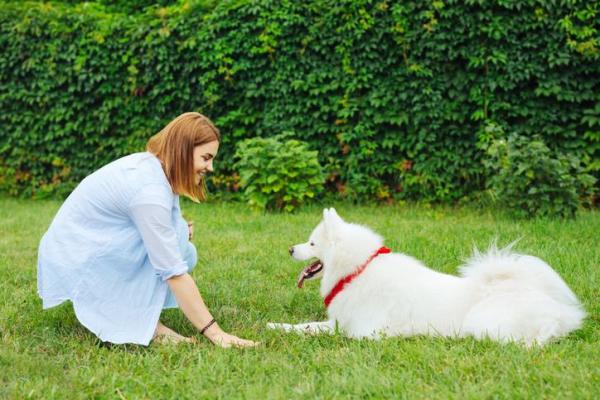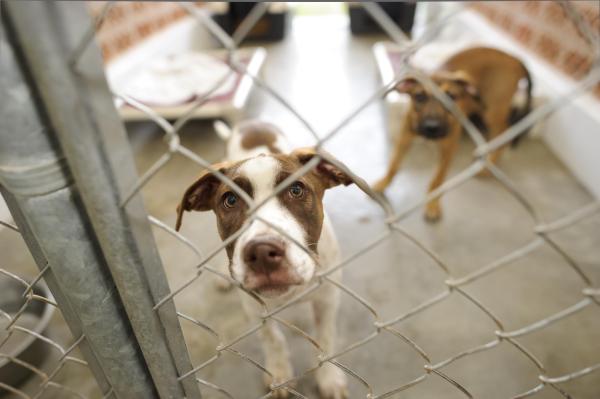Environmental Enrichment for Dogs and Puppies



See files for Dogs
The environment in which you keep your dog affects your dog in many ways. While we should know it is our responsibility to keep this environment safe, we may not be doing all we can to ensure the well-being of our dog. There are certain elements within a dog's environment which can cause them harm, even if they are not a problem for us. For this reason, it is important we find ways to tailor the the dog's environment to make it somewhere in which they can be healthy and feel happy. This is what we call environmental enrichment for dogs.
AnimalWised explains more about environmental enrichment for dogs and puppies. We show you what types of environmental enrichment your dog needs, as well as provide ideas on how to improve it for them.
What is environmental enrichment?
Environmental enrichment is a way to improve the quality of life of animals in captivity through a series of environmental and social stimuli. Such stimuli allow the animal to express the natural behavior of their species, while helping to ensure well-being. This occurs both physically and mentally. In turn, this helps to prevent the appearance of stress and behavioral problems which can occur when a dog is insufficiently stimulated.
Since each animal species has different needs, not all environmental enrichment is the same. In this case, we need to take into account the needs of the domestic canine, as well as explore their natural behaviors and other forms of expression inherent to the species.
The 5 types of environmental enrichment for dogs
In general, we can divide environmental enrichment for animals into the following five categories:
- Cognitive enrichment: promotes mental stimulation by creating scenarios or by providing problems for the dog to solve. In these exercises the dog usually receives a treat as a reward.
- Social enrichment: allows interaction with other dogs and animal species, including humans. Dogs are sociable animals and they need healthy coexistence to others to ensure their well-being, especially with their guardians.
- Sensory enrichment: smells, images, sounds and textures help to stimulate the dog's senses.
- Physical enrichment: rotating changes are made in the animal's environment to increase its complexity, which usually generates greater interest and motivation.
- Nutritional enrichment: food can be used to enrich a dog's environment, but how they eat is as important as what they eat. It can be used to adapt their routine or even be used in conjunction with other types of environmental enrichment for dogs.
Enrichment is especially necessary in shelters for abandoned animals, where suitable environmental enrichment provides an obvious improvement in a dog's well-being over the short term[1]. Similar benefits can be achieved over the long term when we implement environmental enrichment improvements for companion animals in the home.

1. Stimulation games for dogs
Dogs love playing. As puppies, it is a behavior which helps them to learn how to interact with their environment and those within it. As part of their socialization period, it is essential for them to be able to relate to others in a healthy way. While adult dogs will play to a lesser degree, they still use play behavior as a way to stay stimulated and be happy, especially as living with adults mean they are often eternally young at heart.
Using toys and games is a great way to help keep the dog stimulated. For puppies, toys also act as surrogate siblings after they are removed from their mother. Various toys are commercially available, many of which are intelligence games which require problem solving. The kong toy for dogs is a common example as the dog needs to work out to remove the food inside.
It is best for us to rotate the dog's toys so they do not get bored of one. This is a great way to boost environmental enrichment. For more ideas, take a look at our video on different toys for dogs:

2. Dog training and education
Dog training is an excellent tool to improve social enrichment, cognitive enrichment and physical enrichment. Educating our dog is essential for them to learn how to live in our home and adapt to a healthy routine. It will also help us to strengthen the bond we have with our dog.
Especially nervous or anxious dogs will greatly benefit from training and education. Teaching them canine skills will help them to think for themselves, cope with challenges presented to them and generally feel more secure in their environment. It is also physically beneficial as it provides exercise and it is one of the best ways to improve their cognitive abilities.
Do not forget that you should always use positive reinforcement in your training sessions. Also, if you use the expertise of a dog trainer, don't forget to ensure you continue the methods they use (as long as they are successful), otherwise it can hurt its efficacy. Avoid negative reinforcement and scolding the dog as it will cause a counterproductive increase in stress[2].

3. Scent games for dogs
Scent and tracking games are one of the easiest and most fun ways to improve nutritional, cognitive, social and environmental enrichment of the fog. It consists of hiding pieces of food or treats around the home and garden for the dog to find. Scent exercises are especially beneficial for dogs stressed by food anxiety. This is because it prevents them from eating too fast, often causing them to vomit afterwards, as they search out smaller portions.
Start by spreading food in front of the dog in easily accessible areas. This way, the dog can understand how to exercise works. Over time, you can increase the difficulty by making the food more hidden, although you will always need to check they are retrieved. Otherwise you can encourage mice and other vermin.
This exercise encourages the dog to use their senses and think for themselves to extract food from the environment. You will have to vary the hiding places to make the exercise more interesting and enriching over time. Preventing the dog from eating too quickly in this way can also help to avoid certain digestive health problems such as gastritis and gastric torsion.
4. Dog massage
Relaxing massages for dogs are a great way to improve social and sensory enrichment for your dog. It is also a great way to maintain your bond as it relaxes both guardian and companion animal. We need to avoid excessively manipulating certain areas of the dog's body, such as the legs. If we don't, the dog will not find it enjoyable and it will be a counterproductive exercise.
Massages can also be used as relaxation exercises we can carry out to calm them in situations they are stressed. Such situations include going to the veterinarian, travel or when there are fireworks going off outside.
Check out the video below for a full massage therapy lesson for dogs:

5. Walking and canine sports
During the walk the dog does their business, but it also allows them to socialize with other dogs, explore their environment and exercise according to their needs. For these reasons and more, it is one of the most important aspects of a dog's daily routine.
We should moderate exercise and related activities, such as playing fetch, in elderly or sick dogs. However, even when caring for senior dogs, it is highly recommended all do some type of activity, at least going for one walk daily. If you don't have time to walk your dog, then you should consider hiring a professional.

Environmental enrichment in kennels and shelters
Enrichment is especially necessary in shelters and kennels, since dogs in these facilities often face high levels of stress and anxiety. This can lead to behavioral problems and even present in stereotypies and other compulsive behaviors. However, environmental enrichment is more difficult in these cases as the environment itself is limited.
The use of safe and resistant food toys, such as the aforementioned kong, can be good in these environments.They do not have to have much space to play with them and they can help with any anxiety over feeding. This also reduces the amount of barking they might do and generally provides and increase in well-being[3].
Being social animals, dogs can live in groups of two or more individuals, since this increases social behaviors, activity and exploratory behavior. If this is not possible, it is recommended that staff dedicate time to the dog on a daily basis.
Other forms of environmental enrichment for shelter dogs include:
- Changing the usual walking route and allowing them to sniff and explore.
- Perform physical exercise, except in those cases where the dog significantly increases stress.
- Brushing and bathing tolerant dogs.
- Using music to stimulate the dog's hearing, preferably outside the kennels.
- Practicing basic obedience exercises to reinforce them, e.g. sitting.
- Avoiding complex exercises or exercises that stress the dog.
- Scent games while outside.
- Use antivoracity feeders to avoid stress when eating.
- Replacing the kong with frozen food in coolers during summer.
If you want to read similar articles to Environmental Enrichment for Dogs and Puppies, we recommend you visit our Basic care category.
- Schipper, L.L., et al. (2008). The effect of feeding enrichment toys on the behavior of kennelled dogs (Canis familiaris). Applied Animal Behavior Science, 114(1-2), 182-195.
- Deldalle, S., & Gaunet, F. (2014). Effects of 2 training methods on stress-related behaviors of the dog (Canis familiaris) and on the dog – owner relationship. Journal of Veterinary Behavior: Clinical Applications and Research, 9(2), 58-65.
- Schipper, L.L., et al. (2008). The effect of feeding enrichment toys on the behavior of kennelled dogs (Canis familiaris). Applied Animal Behavior Science, 114(1-2), 182-195.
- Mentzel. R. E. (2013). Fundamentals of canine and feline behavior. Publisher MedVet.
- Miklósi, A. (2014). Dog behavior, evolution and cognition. Oxford University Press.
- Henzel, M. (2014). O environmental enrichment not bem-being of cats and cats. Graduation completion work. Federal University of Rio Grande do Sul. Faculty of Veterinary Medicine.








